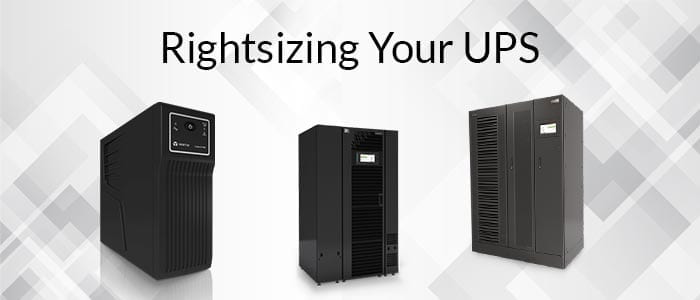An Edge-ucation on Rightsizing Your UPS
Your UPS system is an indispensable workhorse that has dual purposes.
Not only does it provide emergency power via battery backup, it also protects your IT equipment from power spikes, surges, sags, and brownouts.
This level of protection serves to lengthen the life of your IT assets, as well as keep your critical applications running when power is lost.
As more data workloads are housed at the Edge, the UPS has become an even more vital component to your data environment infrastructure.
There are many differentiating factors to consider when selecting the right-size UPS for your environment.
If a UPS is too large for the application, then you are spending more upfront money and physical space than necessary. UPS systems are more efficient the closer they operate to their rated capacity.
If a UPS is too small for the IT load, then it will not provide the required protection and will shut down due to an overload and allow unconditioned utility power to the load and not provide battery backup. Plus, if a UPS is too small then it will not provide enough capacity for future growth.
As your Local Vertiv Office, we consult with data center managers, network engineers, and IT resellers to determine the right-size UPS for a particular application. Our consultation involves asking questions in five key areas, which point to the right-size power solution.
Right-Size Question #1: UPS Capacity
How much IT load do you have today, and how much will you have 5 years from now?
To figure out the right-size UPS for a new application, ask the supplier of the IT equipment to provide the power input for all the equipment. Be sure to ask if the power input is based on operating power or nameplate power. (Operating power is smaller than nameplate power and is more indicative of the power consumed during operation.)
If you are replacing an existing UPS, the IT load may have changed since it was originally installed, and the current size may not be optimized for your current IT load. Many UPS systems have a display showing the load on the UPS in kVA or kW or showing the percent capacity the UPS is currently operating at.
If your existing UPS is operating at 20% of its capacity, then you may be able to replace it with a smaller UPS. On the other hand, if your UPS is operating at 80% to 90% capacity, then you likely need to replace it with a larger UPS.
It’s also important to take into account your near future growth plans in order to avoid having to replace a UPS within a year because it is out of capacity. (Remember, the typical lifespan for a lead acid rack mount UPS is 5 years, so plan for the lifespan of the unit as well.)
Right-Size Question #2: Battery Run Time
Based on the IT load, how much run time do you need with or without a generator to give time for a graceful shutdown of the IT equipment?
If you do not have a generator, the battery run time needs to be long enough to perform a proper shutdown before the batteries run out.
If you have a generator, the battery run time needs to be long enough to allow the generator to start and provide power. This usually takes a minute or two.
Next, consider how stable the grid is in your area. This can affect how many outages you have throughout the year as well as how long the typical outage can last.
Don’t forget, your UPS is not just there to provide backup power in case of an outage. It also cleans up the power from the grid to provide more stable power to your IT equipment.
Right-Size Question #3: UPS Technology
How critical is the equipment on the UPS to justify Off-line, Line Interactive and On-line Double Conversion?
Each type of UPS technology (Off-line, Line Interactive, and On-line Double Conversion) provides different levels of protection.
Off-line (Standby) UPS systems only monitor the incoming electrical feed to detect a loss of power and then switch to battery. These systems do not provide protection against “bad” power such as spikes and small sags.
Line Interactive UPS systems monitor the incoming electrical feed for loss of power and minimal high and low voltage conditions. In addition to battery operation for loss of power, it also provides minimal voltage regulation by use of an auto-transformer.
On-Line Double Conversion UPS systems provide the highest level of protection by using an inverter and rectifier to continuously reconstruct the power output to always provide conditioned power to the IT equipment. On-Line UPS systems offer the widest available voltage regulation without going to battery, thus increasing the lifespan of the battery. Additionally, On-line UPS systems protect the IT equipment from loss of power as well as damaging power problems.
The UPS technology needed is based on the criticality of the operations supported by the IT equipment connected to the server.
While individual work stations may only need an Off-line or Line-Interactive UPS, the more critical equipment operates best with an On-line Double Conversion UPS.
Right-Size Question #4: Power Input/Output
Do you have existing electrical outlets you need to utilize? What kind of output (120 volt, 208 volt, single phase, three phase) do you need going to your IT load?
Input/output voltage influences the design of UPS systems. They need to align with your incoming electrical power to the server room as well as the power requirements of your IT equipment. For Edge environments, this is often either 120-volt or 208-volt.
Next, consider whether the UPS itself offers the correct voltage configuration to meet the input and output needs of the environment, or if your power distribution units or power strips can disperse the correct voltage to your IT equipment.
Right-Size Question #5: Support
Do you have staff to implement the deployment and long-term support of the Edge UPS system? How are you going to monitor and access equipment remotely? Do you have a way to get rid of existing UPSs according to code?
Many companies do not have the staff to handle the installation/removal of a UPS system in Edge environments. Nor do they have a dedicated person responsible for managing all their Edge UPS systems. If a company does have someone on their staff in that role, this person typically does not have the expertise to properly deploy/refresh a UPS system nor the know-how to check battery life and replace batteries when needed.
When selecting a UPS system for an Edge deployment, make certain the UPS manufacturer has the capabilities and programs in place to either assist or provide installation services for the Edge UPS as well as provide battery monitoring and battery changeouts. This will assure the deployment is performed correctly and if it is a UPS refresh, that the old UPS systems are properly disposed according to code.
Get Help to Right-Size Your UPS
As your Local Vertiv Office, we can help you to select and deploy the right-size UPS system that can lengthen the life of your valuable IT hardware while also keeping critical small environments running.
If you’re interested in learning more about selecting the right UPS system, our Buyer’s Guide will help you make informed decision.
Additionally, you can partner with us on the right-size service plan that ensures your Edge environment is optimized and unexpected repair costs are eliminated. Contact us today.

